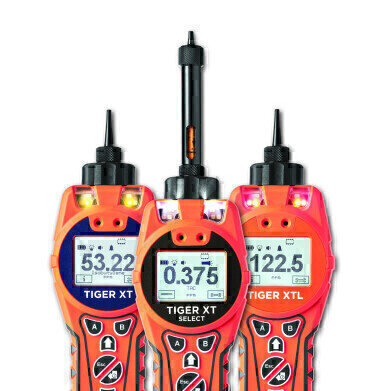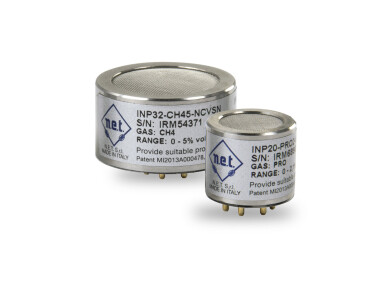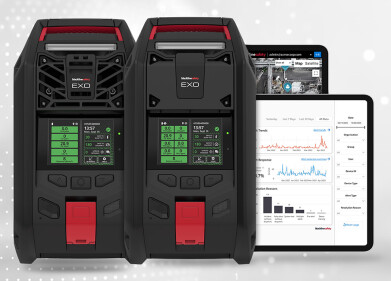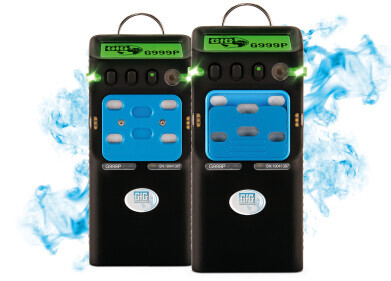Gas detector
A new generation of VOC detectors
Dec 16 2022
The requirement to detect and reduce the release of volatile organic compounds is driven by a number of factors including occupational safety and environmental regulations, as well as the need for companies to perform in line with their environmental, social and governance (ESG) objectives.
Most VOCs are flammable and potentially explosive; some are highly toxic to humans; many are harmful to the environment, and others contribute directly or indirectly to climate change. In addition, the release of VOCs may also represent a loss of inventory. VOC emissions therefore impact people, planet and profit, so effective detection is necessary if VOC emissions are to be lowered.
Portable gas detectors are routinely employed to identify the sources of VOC emissions that may arise from leaks, spills, vents, evaporation, contaminated ground and incomplete combustion, and the most widely adopted measurement technology is photoionisation detection (PID); amethod with which ION Science has been leading the world for many years.
Tiger XT VOC detection range
ION Science has launched a new range of portable VOC detectors, known as Tiger XT, offering users enhanced levels of performance and durability. ION Science Ltd Managing Director Duncan Johns explained: “Our instruments are frequently used in the most challenging conditions; forming part of the essential toolkit for environmental, health and safety staff. As a consequence, we are constantly looking to enhance the durability of our VOC detectors, and the new Tiger XT handheld range, is our toughest yet.”
The new line of detectors retains all of the market leading advantages of its predecessors, the Tiger range, and comprises three models: the entry level Tiger XTL portable VOC gas detector; the Tiger XT portable VOC detector; and the Tiger XT Select benzene detector.
Each Tiger XT product has a humidity-resistant, anti-contamination design and an exterior semi-conductive thermoplastic elastomer outermoulding, making it intrinsically safe.
Power management has also been enhanced in the new Tiger XT instruments, which feature a push-to-release button for the rechargeable battery, allowing for a secure, simple to operate connection. The charger cradle, which can be wall-mounted, charges the li-ion battery in around 8 hours, which provides up to 24 hours of normal operation.
Tiger PC software is supplied with the Tiger XT instrument, enabling users to configure alarms and reminders, and to download data from the onboard datalogger**.
An extensive choice of accessories is available to accompany the Tiger XT range. These include car charger leads and flexi probes for VOC detection in remote and hard-to-access places. A specialist Fire Investigation Kit is available for fire and arson investigators, and customers can request (free of charge) an extended warranty of up to 2-years for the Tiger XTL, and up to 5-years for the XT and XTS models.
Leading-edge PID sensor technology
Each Tiger XT model features the world leading MiniPID sensor technology, this is critically important for the instruments’ performance, offering a rapid response, extremely low levels of detection and an exceptionally broad measurement range.
In combination, the advanced features of the MiniPID 2 sensors mean that the Tiger XT can detect gases at levels as low as 1 ppb, withmeasurements up to 20,000 ppm; the broadest range of any VOC detector on the market today.
Summarising the advantages of the new Tiger XT range, Elliot Rosher, Global Sales Manager says: “Our customers’ requirements are simple; they want great sensitivity, but with a wide measurement range, and they want reliable, stable readings without any effects from temperature orhumidity. Importantly, they want their instruments to be extra tough, so we think they are going to be absolutely delighted with the new Tiger XT range.”
Benzene
VOCs frequently exist as a mixture of hydrocarbon vapours, and this presents a measurement challenge if one of the components, such as benzene, is particularly hazardous. The new Tiger XT Select Benzene has therefore been developed to selectively measure benzene.
Benzene is used in the manufacture of plastics, detergents, pesticides, synthetic fibres, rubber, lubricants, dyes and many different chemicals. It also exists in all process streams in the production or processing of oil and gas, as well as in produced water. Exposure to benzene typically occurs through leaks and spills, and when confined systems are opened for sampling, product transfer, inspection or maintenance, or loadingand unloading during transport. Engine exhaust and cigarette smoke contain benzene and contaminated materials such as soil, paint and solvents can also present a threat.
People at risk of benzene exposure include those working in oil refineries; chemical and petrochemical plants, including some offshore installations; coke works; foundries, during casting (where benzene sulphonic catalysts are used); and where petrol/gasoline or benzene is stored or distributed.
Benzene exposure occurs by breathing air containing benzene vapour; by absorption through skin; or by swallowing. The health effects depend on the concentration of benzene and the length of exposure time. The immediate effects of exposure to a high concentration (hundreds of ppm or more) can include tiredness, dizziness, headache and nausea. However, benzene can also cause unconsciousness at high levels (thousands of ppm). Importantly, benzene is a carcinogen and long-term exposure to lower concentrations of benzene can result in bone marrow suppression and serious blood disorders, as well as leukaemia.
International regulations have established benzene limits, imposing requirements on employers to assure that no employee is exposed to an airborne concentration of benzene in excess of the TWA (time-weighted average) limit. In the USA and in most European countries, the 8-hour TWA limit is 1ppm, although lower levels have recently been proposed in Germany. Similarly, the American Conference of Governmental Industrial Hygienists (ACGIH) has proposed a lowering of the benzene 15-minute STEL (short-term exposure limit) and TWA limits. Currently, the OSHA permissible exposure limit (PEL) is 1 ppm (8-hr TWA), and 5 ppm during any 15-minute work period. The NIOSH recommended airborne exposure limit (REL) is 0.1 ppm (10-hr TWA) and 1 ppm during any 15-minute work period.
Advanced technology for detecting total aromatics or benzene
The new Tiger XT Select (XTS) utilises the ION Science 10.0 eV lamp to detect Total Aromatic Compounds (TACs) such as benzene, toluene andxylene down to concentrations as low as 1 ppb. The instrument is supplied with a pack of benzene pre-filter tubes, which enable the selective detection of benzene. This speciation capability for benzene is a major advantage, given the toxicity and associated regulations that apply to benzene, along with the complexity and cost of alternative benzene-specific measurement techniques.
In order to measure benzene, users simply attach a pre-filter tube to the Tiger XTS, which removes other VOCs, so that benzene can be detectedin isolation. Throughout the measurement process, the Tiger XTS displays real-time data. It can also provide average measurements for automatic comparison with 15-minute STELs and 8-hour TWAs. To protect the safety of workers, as well as the operators of the Tiger XTS, thedevice is able to provide visual, audible and vibration alarms. The Tiger XTS can also be used in a standard VOC detection mode without the use of a benzene pre-filter tube.
As the latest generation of ION Science’s world-leading VOC detectors, the Tiger XT range represents the leading edge of gas detectiontechnology; enabling users to protect staff and improve environmental performance.
Digital Edition
PIN 25.6 Buyers' Guide
January 2025
Buyers' Guide Directory - Product Listings by Category - Suppliers Listings (A-Z) Articles Analytical Instrumentation - ASTM D7042: The Quantum Leap in Viscosity Testing Technology -...
View all digital editions
Events
Feb 25 2025 London. UK
SPS Smart Production Solutions Guangzhou
Feb 25 2025 Guanghzou, China
Feb 27 2025 Kathmandu, Nepal
Mar 01 2025 Boston, MA, USA
Mar 02 2025 Bethesda, MD, USA



















